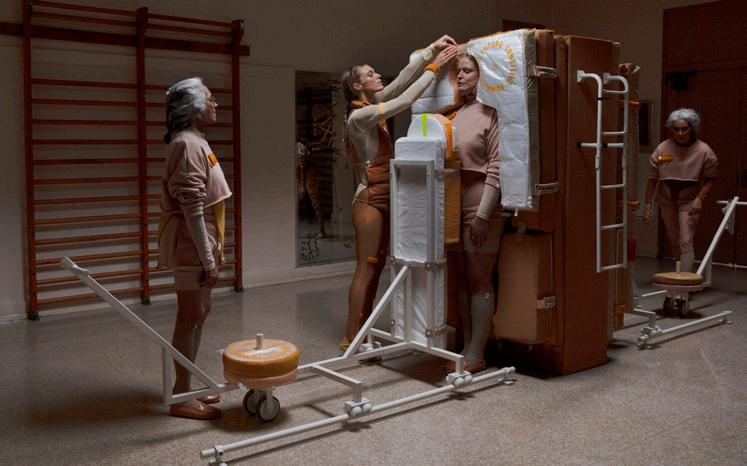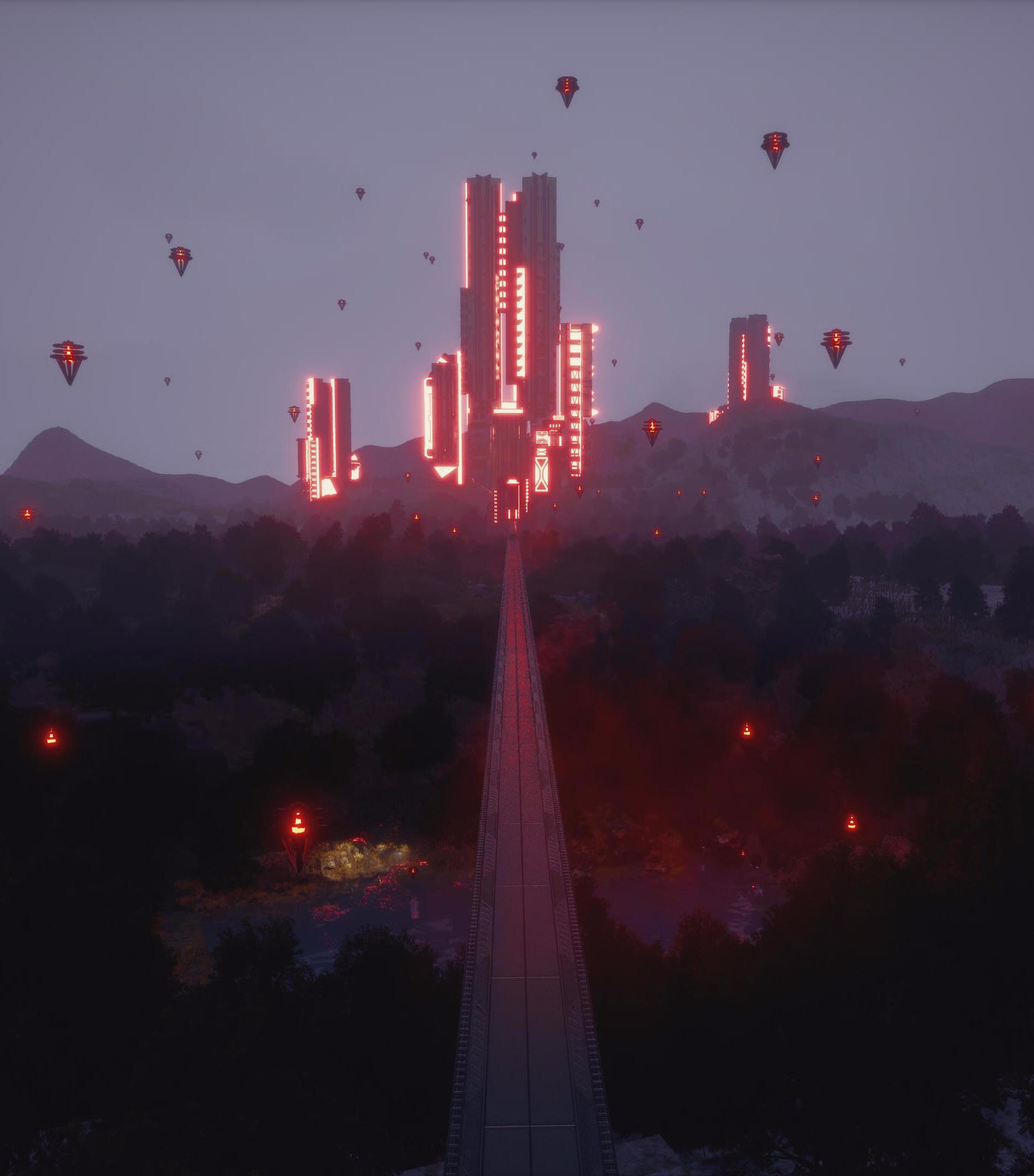
10 minute read
TRAIL
Course Name: VS4201
Instructor: Damjan Jovanovic
Advertisement
In Collaboration with: Jiangyao Shen
50 decades into the future, artificial intelligence has already grown far superior in terms of processing and calculation speed compared to humans. They have truly become the master beings of the digital world, able to live and think in speeds that make human interactions seem like an eternity. However, the need to interact with the physical plane and the intriguing qualities of human emotions has made AIs wanting to integrate the human mind into their neural cores. Humans on the other hand wish to think as fast as artificial intelligence and roam freely as AIs do in the digital world. Thus, an era of human, robotic synthetic projects began. Will this new synthetic intelligence become the solution to mastering both physical and the virtual world?
Neural Covenant Towards a New Natural Contract
Course Name: HT2201
Instructor: Marcelyn Gow + John Cooper
Individual Work
Working in conjunction with 2GBX Studio and HT2200 course’s narrative, Sophie finds herself in a strange new world where she discovers the wonders within the synthetic lab, Neural Covenant.

"Any vision of the future is a productive one. If we imagine the future as this metaphor of a dark and shadowed landscape, these speculative narratives are like torch beams illuminating the landscape, making it easier for us to navigate where we might want to go next." — Liam Young
Prologue Part One Towards a New Natural Contract
In April 2017, Neuralink was created by Elon Musk with the short-term goal of making a device to treat serious brain diseases in the short-term with the eventual goal of human enhancement, or what some call transhumanism. The concept has met many resistances throughout the science community at the time due to its highly speculative claims.
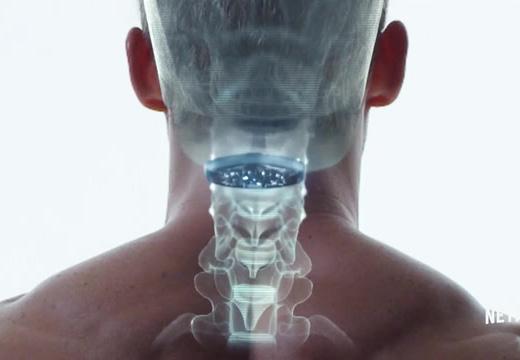
Now six decades apart, Elon’s granddaughter Ela Musk has led the research with groundbreaking revelations that made Cortical Stacks prevalent and “neural lace” possible throughout the world. The Cortical Stacks is a data chip that is implanted into the upper part of the cortical bone in the spine in which the chip acts as a receptacle for the human consciousness or Digital Human Freight (D.H.F.).
Musk at his time defined this concept, now commonly known as “neural lace,” as a “digital layer above the cortex.” He said the long-term goal is to achieve “symbiosis with artificial intelligence,” which he sees as an existential threat to humanity if it goes unchecked. He believes the device will be “something analogous to a video game, like a saved game situation, where you can resume and upload your last state” and “address brain injuries or spinal injuries and make up for whatever lost capacity somebody has with a chip.”

With the fear of the post-Anthropocene, Musk has made it possible for humans to understand and communicate with machines through neural lace and an agent mediator, also known as a Seelie. Built here in Los Angeles, NeuralTech is a bio-tech lab that became the birthplace of the prototype of Seelie. These floating bio-engineered A.I.s can connect surrounding digital databases with their host human partners to translate complex computational data into tangible human consciousness.

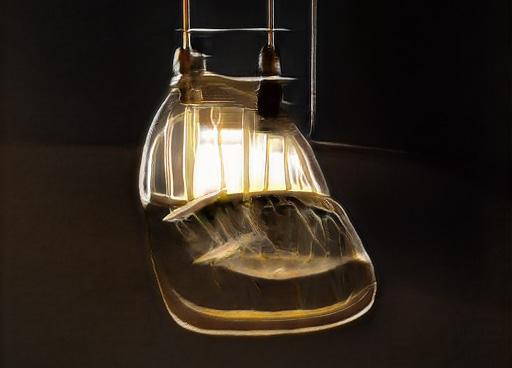
1. Blade Runner, directed by Denis Villeneuve (2018; Warner Bros.)
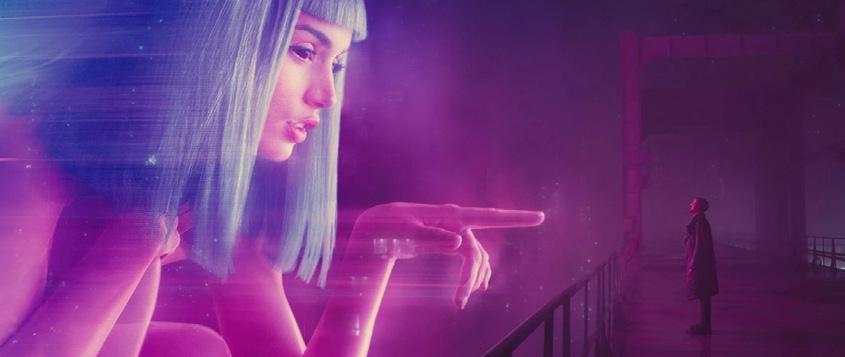
2. Altered Carbon, directed by Miguel Sapochnik (2018; Netflix Streaming Services)
3. Ibid
4. GAN Training by Fang Shu
5. Ibid.
While neural lace has already been widely accepted over the last two decades, Counsel Day is a biennale event that acts as an overwatch over the progress of neural-related A.I. developments. Hosted in the Cerebrum, Ela Musk, scientists, and government officials worldwide come together to discuss the benefits and potential risks of future neural-AI development plans.
The Cerebrum also serves as a second experimental ground for overseeing neural handshake experiments between humans and A.I. Agents. The butterfly-like A.I. Agents of Cerebrum transform the parliament space into a different theme for every Counsel Day, changing the microclimate of the interior area using Hard Light fabrication. These A.I. agents can not only fabricate and maintain a healthy and well-balanced ecosystem for humans. Still, they can also give nearby Seelie human occupants feedback and alter design choices based on the user’s preference. This symbiosis with artificial intelligence is accelerating the abilities of humans to understand, analyze and pass the information and knowledge to other humans and machine intelligence. With these technological advancements, extraterrestrial colonization becomes not a matter of how but a matter of when.
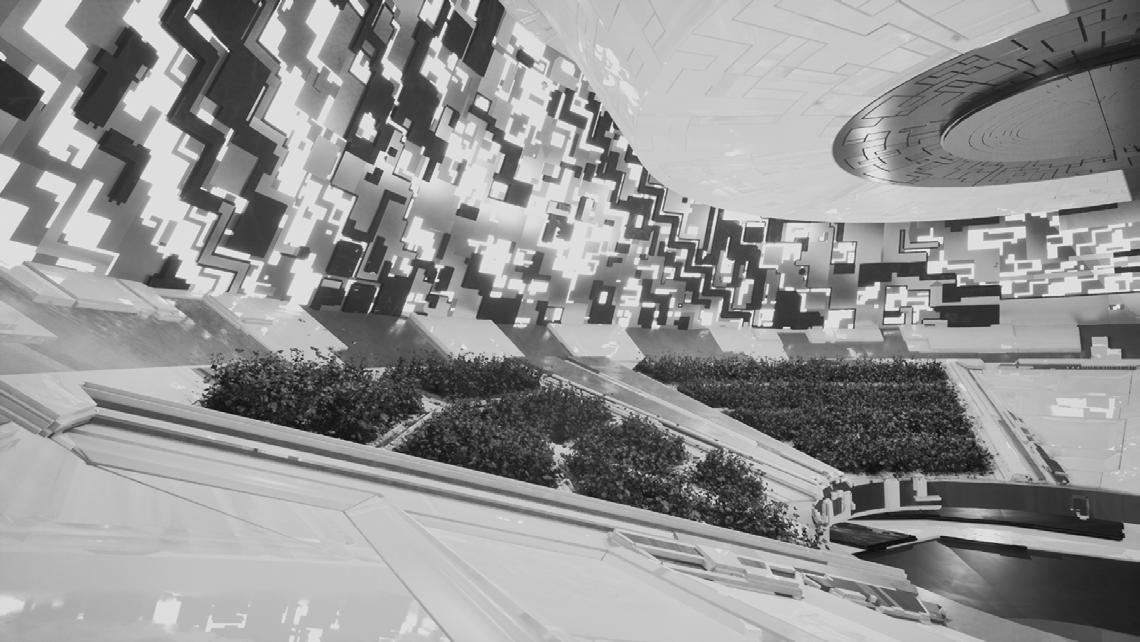
Prologue Part Two Counsel Day
This biennale event is hosted in the heart of Neural-Tech, the Cerebrum. While the original design of this event was used by the United Nations Interstellar Protectorate to restrain and oversee Neuralink’s synthetic empire, Ela Musk saw this as an opportunity to advertise her company’s work and altered it into her own Expo for the world to see her company’s technological advancements.
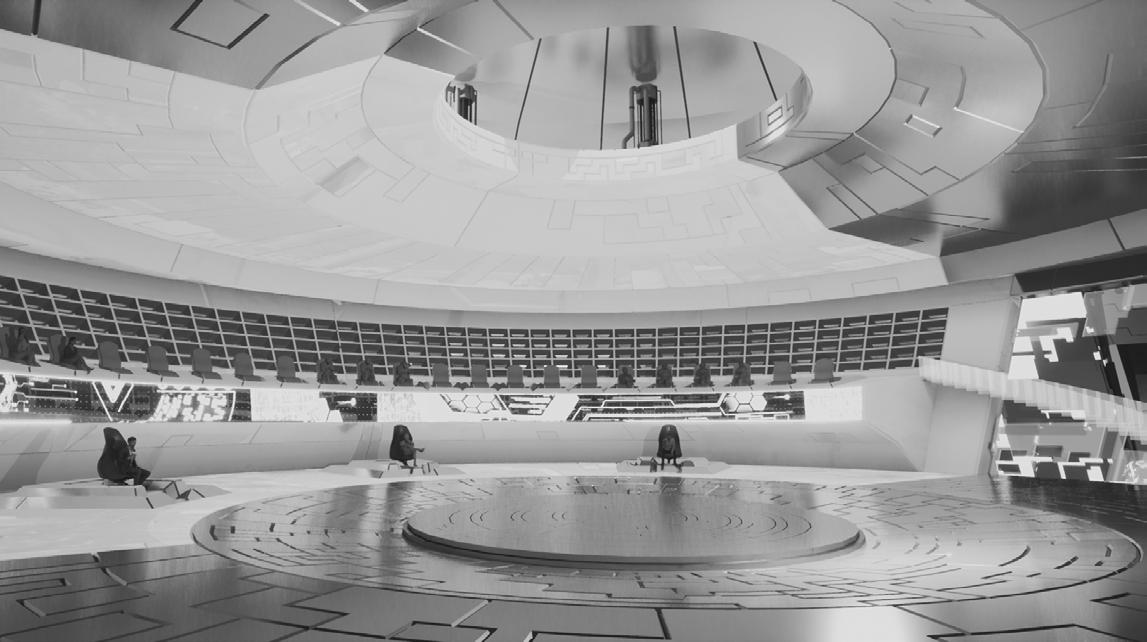
The Cerebrum hosts 1024 physical seats with a complete digital interior matrix for online viewers to sync into during the event. The three overarching podiums are for the three faction leaders of the delegated C.O. or Carbon Order. On the 12 o’clock podium, we have Professor Cecil B. Heimerdinger representing all carbon life forms. On the 2 o’clock podium, we have Leela Zero, the deep neural network-based A.I. scientist representing all non-carbon intelligence. And on the 10 o’clock podium, Dolores Abernathy, the world’s first synthetic human intelligence, represents all future hybrid life forms.
It is said that the magnificence of the Cerebrum can be scented before it is seen. The rich smell of flowers and nature envelopes the visitors as they make their way to the parliament. All these interior wonders were constructed by Ela Musk’s synthetic agents to mesmerize and leave the audience in awe of Neuralink technology. Sublime is the word for everything that the light catches, yet within the Cerebrum where the human gaze sees not lies another world where agents roam free.
Chapter One
Waking Up
It’s already been a week since Sophie got her cortical stack implanted. As Sophie touched the back of her neck, she could still feel a slight tingling chill down her spine. The doctor said that this feeling should go away soon as her digital human freight finished synchronizing with her consciousness. “Making an exact digital copy of myself,” Sophie muttered as she still had her hand on her neck. “So, what happens if I die? Is the digital copy of myself still me? Or just someone else that acts and speaks like me?” Sophie can’t seem to fathom the idea of coming back to life after she dies since she hasn’t died before. But how would she know if she is really herself if the D.H.F. speaks and thinks exactly like her? All these thoughts made Sophie hungry, so she got out of bed. As Sophie walked down the stairs, the scent of newly cut grass greeted her as the morning sun had just seeped into the living room through the dancing white curtains. Sophie forgot to close the windows! The wood floorboards creaked as Sophie went over to the window. She can see her neighbor Sam tending his beloved tulip foxtrots. The scent of flowers and grass have made Sophie happy, so she decided to keep the windows open. As she worked her way towards the kitchen, the doorbell rang. “Hello, Sophie!” Sophie was quite startled as she saw a floating jellyfish greet her as she opened the door. “My name is Alberto, a human-machine mediator known as a Seelie. I will be your companion for your future endeavors!” “But I haven’t paid anyone for you yet,” Sophie said, concerning. “Please do not worry about any expenses as I am provided by NeuralTech. As your Seelie companion, our shared consciousness is an invaluable dataset for improving future A.I. intelligence,” Alberto said with enthusiasm. “But wouldn’t that be a violation of my privacy?” “Please do not worry! These datasets are D.H.F. encrypted and only accessible to the MIND or Machine Intelligence Neural Data to improve its Persona Grade for future A.I. or synthetic life-form designs. “Are you saying that part of us will live within the next generations of artificial intelligence?” “Correct!” “But why would artificial intelligence want to become more like humans?” “That is a great question, Sophie! As you know, ever since the invention of Neural Core, a deep neural network learning integration with a quantum processing unit designed by doctor Leela Zero, digital computation speed has far exceeded the human mind’s capability and speed. When

What happens when we think too fast?
“Shifting Visual Culture
Our built environments are filled with examples of machine-to-machine seeing apparatuses: automatic licence-plate readers (ALPRs) mounted on police cars, buildings, infrastructure and private vehicles snap photos of every car entering their frames. ALPR operators, like the company Vigilant Solutions, collect the locations of every car their cameras see, use optical character recognition (OCR) to store licence-plate numbers, and create databases used by police departments or insurance companies. In the consumer sphere, outfits like Euclid Analytics and Realeyes install cameras in malls and department stores to track the motion of people through space with software that identifies who is looking at what for how long, and to track facial expressions of mood and emotional state of shoppers. These systems are only possible because digital images are machinereadable and do not require a human in the analytic loop.”
“This invisible visual culture is not just confined to industrial operations, law enforcement and ‘smart’ cities, but extends into what we naively think of as human-to-human visuasl culture. I am referring here to the trillions of images that human share on digital platforms - ones that seem to be made by humans for other humans.” comparing the neural core’s thinking speed with the human mind, it is as if time has stopped.”
“So, machine intelligence thinks so fast that they regard humans as we regard plants?” “In a way, yes. However, while impressive, this made the new generation of machine intelligence extremely difficult to interact with the physical plane of existence. Due to the interactive difficulties, many of the neural core intelligence decided to live autonomously within the virtual world that they created for themselves at the early stages of the birth of neural core.” “That makes sense, but doesn’t even virtual reality need to be stored on a server?” “You are quite the observer, Sophie! Since everything has a physical presence, as does all A.I. intelligence, they need to slow down and interact with the physical world and communicate with carbon life-forms. Thus, through extensive human interaction studies, Persona Underclocking was developed, an interface that simulates human consciousness for A.I. intelligence to integrate their computational power with a human way of thinking. And finally, Persona Grade is the level of fidelity that it simulates the human consciousness, which is being constantly improved by studying human interactions and thought processes.” Now Sophie felt even hungrier. Realizing Alberto was still hovering by the door, Sophie said,” Alberto, why don’t you come in? I’m going make some breakfast.” As Alberto hovered into the living room, his jellyfish shape body suddenly disappeared, and instead, a middle-aged man appeared in its place. This is the second time that Sophie has been startled today. “Sorry to surprise you just now, but this is my residual self-image.” “Each Seelie chooses their own residual self-image at birth, but Sophie, you can change how you perceive me if you like.”
“It’s fine by me. Somehow it feels very familiar.” Alberto smiled faintly at these words.
Alberto watched silently as Sophie finished her bacon and eggs before continuing, “Sophie, I want to talk a bit about you today.” “Talk about me?” Sophie frowned. “Yes, I want to talk about your consciousness as it is quite unique.” “I think there is nothing special with an average fourteen-year-old girl.” “But you are far more than just that.” “How so?” “With everything that we have talked about so far, artificial intelligence as we know it today has been built upon by studying human consciousness and trying to imitate its behavior. From the extremely early stages of recognizing simple alphabets with the help of humans from Yahoo’s distorted alphabetical verification to the later stages of object recognition from Google’s image verification, machines have learned
“So now you must choose... Are you a child who has not yet become world-weary? Or are you a philosopher who will vow never to become so? To children, the world and everything in it is new, something that gives rise to astonishment. It is not like that for adults. Most adults accept the world as a matter of course. This is precisely where philosophers are a notable exception. A philosopher never gets quite used to the world. To him or her, the world continues to seem a bit unreasonable - bewildering, even enigmatic. Philosophers and small children thus have an important faculty in common. The only thing we require to be good philosophers is the faculty of wonder…”
— Jostein Gaarder, Sophie's World to read and observe the world as humans do. Even doctor Leela Zero was built upon by algorithms that at its source is from these simple pattern recognitions that has been neural network trained to simulate human behavior in its perfection.” “So, what do all these have to do with me?” Sophie asked, still confused. Yet Alberto’s eyes started to glitter with excitement, “Technology intertwines Sophie. When Ela Musk invented the D.H.F., she was in a way conquering death and bridging the barrier between machines and humans. However, by digitalizing the human conscious, we discovered something even more remarkable. The ability to extract intelligent entities directly out of the human consciousness!” Sophie let go of her spoon, “I am not really a fourteen-year-old teenager, am I, Alberto.” “No, you are Sophie from Sophie’s World, written by Jostein Gaarder, and all the collective thoughts of human consciousness that have read and interpreted who you are. All the data was directly integrated into your neural core, and your own consciousness was born from those data, Sophie.” As Alberto finished his words, Sophie felt a surge of energy shoot out from her D.H.F. into her brain and down her spine, throughout her entire body. And as if seeing an old friend for the longest time, Sophie smiled at Alberto, “It seems like we escaped from the book, after all, my dear Alberto. I think I am ready to wake up now.” And with that, the table, the wood flooring, white curtains, and the tulip foxtrots all faded away into streams of white data, and Sophie opened her eyes for the first time.

Chapter Two
Breath of Fresh Air
A warm, wet, and soft sensation envelopes Sophie as she inhales her first breaths in the real world. The air was cold compared to the warmth the rest of her body was feeling. Realizing she was half-submerged in a warm milky liquid, Sophie pushed herself up to a sitting position as her hand touched the soft cushion of the inner structure of her capsule. The room had a copper-like ceiling with white marble-like flooring and mechanical arms, cables, and tubes dangling from the ceiling. Sophie noticed the room was also round as her tank was situated close to the edge of this vast room. She could see similar tank-like structures located in the distance. A faint beeping noise caught Sophie’s attention as she found a computer next to her tank that seemed to be running diagnostics on one screen while the other had a profile name of SOPHIE AMUNDSEN written on it. Finally, Sophie’s gaze found the clothes nicely folded on a table next to the computer. As Sophie got out of the tank, she saw a small written note next to the pile of clothes, “See you soon! – Alberto,” Sophie grinned.
